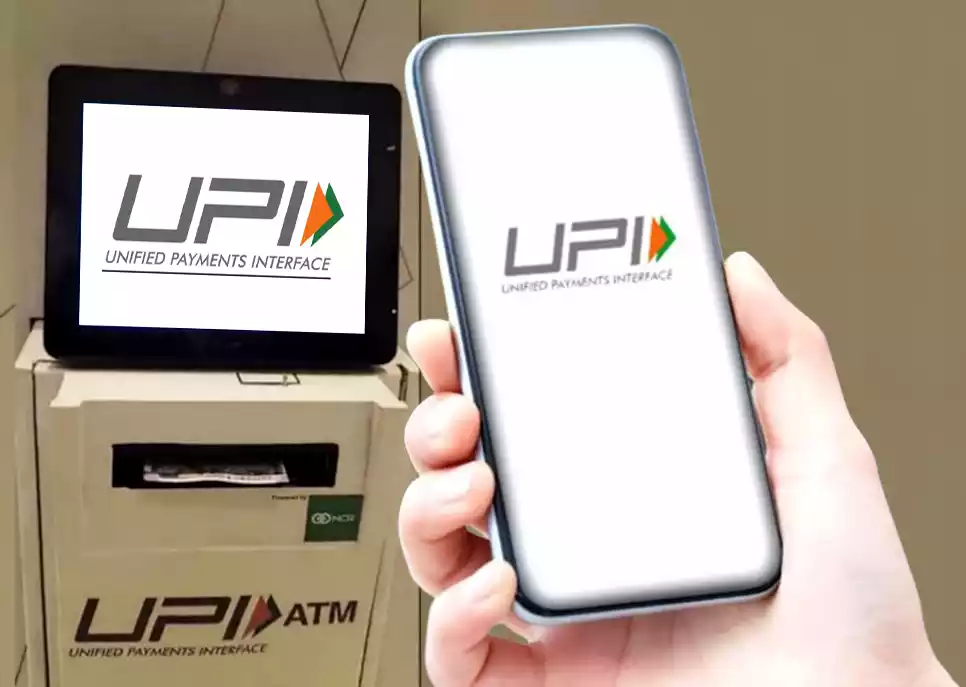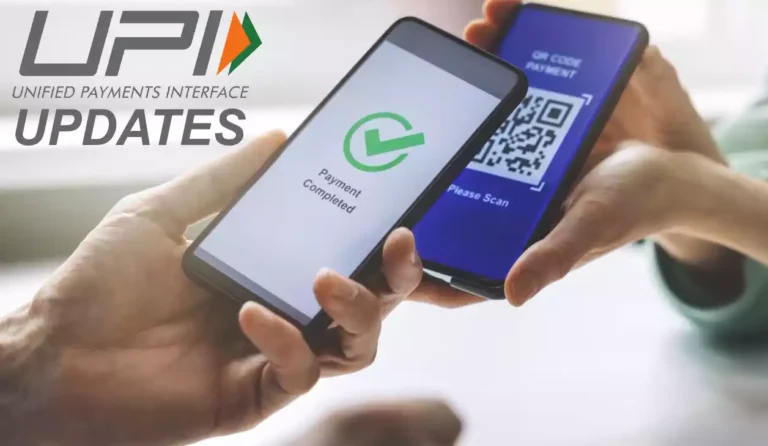Welcome to our detailed guide on the five major updates in UPI transactions that have been implemented since January 2024. As the digital payment landscape continues to evolve, it is important to stay informed about the changes that affect our everyday financial transactions. In this article, we will explore the latest updates in UPI transactions, including the introduction of UPI ATMs, increased transaction limits, changes in interchange fees, deactivation of inactive UPI IDs, and the implementation of a time limit for transactions. Let’s dive in!
1. UPI ATMs to be Introduced Across India

The Reserve Bank of India (RBI) plans to introduce UPI ATMs across India, allowing cash withdrawal by scanning a QR code.
One of the most exciting developments in UPI transactions is the introduction of UPI ATMs across India. These ATMs will revolutionize the way we access and utilize our UPI accounts. Similar to traditional ATMs, UPI ATMs will allow users to withdraw cash, check their account balance, and make payments using their UPI IDs instead of bank account numbers or IFSC codes. This will provide convenience and ease of use, especially for individuals who prefer using UPI for their day-to-day financial needs.
What is a UPI ATM?
Imagine an ATM that doesn’t require a debit or credit card – just your smartphone and a simple QR code scan. That’s the magic of a UPI ATM. These innovative machines utilize India’s revolutionary Unified Payments Interface (UPI) to allow you to withdraw cash instantly, using the bank account linked to your UPI app.
The Benefits of UPI ATMs:
- Convenience: No more scrambling for your debit card or pin. Just scan, enter your UPI PIN, and voila – cash in your hand!
- Security: Forget skimming scams and card thefts. UPI transactions are secured with a multi-layered authentication process, making them incredibly safe.
- Accessibility: UPI ATMs are perfect for areas with limited access to traditional banking infrastructure. They bring convenient cash withdrawals to even the remotest corners of India.
- Financial Inclusion: By eliminating the need for debit cards, UPI ATMs empower users without bank accounts to participate in the formal financial system.
- Cost-effective: Say goodbye to hefty ATM transaction fees. UPI ATMs typically charge minimal fees, making them a more pocket-friendly option.
Where Can You Find UPI ATMs?
The rollout of UPI ATMs has just begun, but they are gradually popping up across major cities in India. Hitachi Payment Services, in collaboration with NPCI, has launched the country’s first UPI ATM, and several other banks have announced plans to deploy their own networks. Keep your eyes peeled for these futuristic machines or inquire with your bank to find out if they have any installed or planned installations in your area.
The Future of Cash Withdrawal:
While traditional ATMs won’t disappear overnight, UPI ATMs represent a significant leap forward in financial convenience and security. They have the potential to revolutionize the way we access cash, making it faster, simpler, and more inclusive for everyone.
Get Ready to Embrace the Change:
As UPI ATMs gain traction, it’s crucial to stay informed and adapt to this new wave of banking. Familiarize yourself with the process, download your bank’s UPI app if you haven’t already, and be prepared to ditch the plastic in favor of a scan-and-go experience.
2. Increased Transaction Limit
From January 2024, UPI transactions have seen a significant increase in the transaction limits. Previously, users were limited to a maximum transaction amount of ₹1 lakh per transaction. However, with the new updates, the transaction limit has been increased to ₹5 lakhs per transaction. This means that users can now perform larger transactions through UPI, offering a greater level of flexibility and convenience for high-value transactions.
- P2P and P2M (Non-Verified): The basic limit remains at ₹2,000, ensuring secure everyday transactions.
- P2M (Verified Categories): This limit has doubled from ₹1 lakh to a whopping ₹2 lakh for verified merchants like utility providers, insurance companies, and educational institutions. Say goodbye to multiple bill payments and tuition fee hassles!
- Hospitals and Educational Institutions: This is where the biggest leap occurs. The limit has skyrocketed from ₹1 lakh to a generous ₹5 lakh! No more worrying about splitting hefty medical bills or school fees. Your healthcare and education expenses just got a smooth digital upgrade.
Benefits Beyond Big Numbers:
This upgrade isn’t just about bragging rights for bigger transactions. It unlocks a cascade of benefits:
- Convenience: No more juggling multiple payments for large expenses. Pay bills, fees, and dues seamlessly in one go, saving time and effort.
- Transparency: Clearer pricing for merchants with higher transaction limits, eliminating hidden fees and charges.
- Wider Adoption: Increased limits incentivize businesses to accept UPI, fostering wider digital payment adoption.
- Financial Inclusion: Easier access to healthcare and education through convenient bill payments, promoting financial equality.
Navigating the New Limits:
Remember, these increased limits might not be available on all platforms and accounts immediately. Check with your bank and UPI app for specific details and activation timeframes. Additionally, some merchants might choose to stick with lower limits, so keep an eye out for any notifications before initiating a large transaction.
Embrace the Upgrade:
The increased transaction limits mark a significant step forward for UPI, solidifying its position as the go-to payment platform for Indians. So, embrace the upgrade, explore the new possibilities, and experience the freedom of larger digital transactions with UPI!
3. Interchange Fee
The introduction of UPI transactions came with the promise of free and instant transfers between bank accounts. However, with the new updates, a nominal interchange fee has been introduced for certain types of UPI transactions.
The Unified Payments Interface (UPI) has revolutionized digital payments in India, offering instant and convenient cashless transactions. However, a crucial aspect of UPI transactions is the interchange fee, a small percentage charged by the issuing bank of the customer’s debit or credit card to the acquiring bank of the merchant. While these fees were initially absent in UPI, a recent revision introduced a tiered structure ranging from 0.5% to 1.1%, depending on the type of service.
Breaking Down the Tiers:
- 0.5% Fee: This applies to fuel payments, making it the most cost-effective category within UPI transactions. Imagine filling up your tank without worrying about hefty transaction charges – that’s the convenience of a 0.5% fee!
- 0.7% Fee: This tier covers a wider range of services, including post office transactions, telecom bills, utility payments, agricultural purchases, and educational expenses. Sending money for school fees or paying your phone bill now comes with a minimal 0.7% fee.
- 0.9% Fee: Supermarket shopping becomes slightly more expensive with a 0.9% interchange fee. However, compared to traditional card transaction fees, this still represents a significant cost saving.
- 1.1% Fee: This top tier applies to insurance payments, mutual funds, government transactions, and railway bookings. While slightly higher than the other categories, the 1.1% fee ensures a sustainable ecosystem for these essential services within the UPI network.
Impact and Implications:
The introduction of interchange fees has sparked discussions about its potential impact on user behavior and merchant adoption. While some users might perceive the fees as an inconvenience, the overall effect is expected to be minimal, especially considering the capped nature of the charges. For merchants, these fees could potentially lead to lower processing costs and encourage wider adoption of UPI for various services.
Transparency and the Road Ahead:
As UPI continues to evolve, ensuring transparency and clear communication regarding interchange fees will be crucial. Users should be informed about the applicable fee for each transaction, while merchants should have the flexibility to decide how they handle these charges. Ultimately, the success of the revised fee structure hinges on a balanced approach that benefits both users and merchants while promoting the continued growth and sustainability of the UPI ecosystem.
4. Deactivation of Inactive UPI IDs
Remember that old UPI ID you created years ago for a one-time payment? Or the one linked to a phone number you haven’t used in ages? Well, get ready to say goodbye! The National Payments Corporation of India (NPCI) is on a mission to declutter the digital payment landscape, and inactive UPI IDs are the first targets.
Why the Clean Up?
Think of your digital wallet like your physical one. Leaving unused cards and expired IDs cluttering it up not only creates chaos but also poses security risks. Similarly, inactive UPI IDs can create vulnerabilities and hinder the smooth functioning of the UPI ecosystem. Here’s why the deactivation is a positive step:
- Enhanced Security: Dormant accounts are often targeted by fraudsters for unauthorized transactions. Deactivating them minimizes this risk, making UPI even more secure.
- Streamlined Transaction Processing: Fewer inactive IDs mean faster and smoother processing of genuine transactions, improving the overall UPI experience.
- Clearer Ecosystem View: With inactive IDs out of the way, merchants and payment service providers gain a clearer understanding of active users, enabling them to tailor their offerings more effectively.
What Does “Inactive” Mean?
Any UPI ID linked to a phone number that hasn’t been used for financial or non-financial transactions for over a year will be considered inactive. This includes:
- Sending or receiving money
- Linking or unlinking bank accounts
- Checking account balance or transaction history
What Happens to Deactivated IDs?
Deactivated IDs become unusable for receiving funds. However, you can easily reactivate them by performing any financial or non-financial transaction through the linked app. Remember, reactivation might require verification depending on the app’s specific policies.
What If You Need to Access an Old ID?
If you need to access an old ID that’s been deactivated, your best bet is to contact the linked bank or the app you used to create it. They can guide you through the reactivation process or help you create a new ID if needed.
How to Stay Active:
To avoid deactivation, simply use your UPI ID for any transaction, financial or non-financial, at least once within a year. This could be anything from paying a bill to checking your balance.
Benefits Beyond Decluttering:
The deactivation process isn’t just about cleaning up the system; it also has wider benefits:
- Promotes Responsible Digital Finance: It encourages users to be mindful of their digital footprint and manage their online accounts responsibly.
- Boosts User Confidence: A cleaner and more secure UPI ecosystem fosters trust and confidence among users, further accelerating digital payment adoption.
Embrace the Change:
The deactivation of inactive UPI IDs might seem like an inconvenience at first, but it’s ultimately a positive step towards a more robust and secure digital payments landscape. Remember, a clean and organized digital wallet is just as important as a physical one in today’s fast-paced world. So, embrace the change, stay active, and enjoy the seamless convenience of UPI transactions!
5. Time Limit
Another significant update in UPI transactions is the implementation of a time limit for completing transactions. Previously, UPI transactions had no specific time limit, which sometimes led to delays or unresolved transactions.
But a new twist is coming to the world of UPI! The RBI is considering the introduction of a 4-hour window for second thoughts on certain UPI transactions, adding a layer of safety and preventing potential financial hiccups. Let’s unpack this proposal and explore its implications for your digital wallet.
The 4-Hour Safety Net:
Imagine sending a large UPI payment for the first time to a new recipient. What if you make a mistake or experience buyer’s remorse? Right now, the money disappears into the ether instantaneously. But with the proposed “4-hour window,” you might have a chance to rectify the situation. Here’s how it would work:
- This time limit would apply to initial high-value payments exceeding ₹2,000 sent to new recipients you haven’t previously transacted with.
- Within that 4-hour window, you would have the option to modify or even reverse the transaction, potentially minimizing the risk of sending funds to the wrong person or regretting a hasty purchase.
Benefits and Potential Concerns:
While this proposal promises peace of mind and added security, it also raises some questions:
Benefits:
- Reduced error risk: The buffer period allows you to catch typos, incorrect recipient details, or accidental overpayments before they become permanent.
- Buyer’s remorse protection: For impulsive purchases or unexpected situations, the window provides an opportunity to reconsider and potentially cancel the transaction.
- Enhanced confidence: This feature could encourage hesitant users to embrace high-value UPI transactions with greater confidence.
Potential concerns:
- Fraudulent misuse: Scammers might try to manipulate the system by initiating fake transactions with new victims within the 4-hour window.
- Merchant inconvenience: Businesses might face delays in receiving confirmed payments, impacting their cash flow management.
- Technical complexities: Implementing this feature across various UPI platforms and banks might require substantial technical adjustments.
The Road Ahead:
The proposal is still under discussion, and its final form and implementation timeline remain unclear. However, it sparks an important conversation about user safety and convenience within the rapidly evolving UPI landscape. Open discussions and careful consideration will be crucial in ensuring the effectiveness and feasibility of this initiative.
Staying Informed and Adapting:
As UPI regulations and features continue to evolve, it’s essential for users to stay informed and adapt to the changes. Keep yourself updated on the latest developments, be cautious about sharing financial information, and utilize available transaction confirmation and reporting mechanisms to secure your digital payments.
Remember, the “4-hour window” proposal, if implemented, would add another layer of protection to your UPI experience. While it comes with its own set of considerations, it ultimately reflects the commitment to building a robust and user-friendly digital payment ecosystem for India.
End Note on Updates in UPI Transactions
The updates in UPI transactions from January 2024 have ushered in significant changes that aim to enhance the convenience, security, and efficiency of digital payments in India. With the introduction of UPI ATMs, increased transaction limits, interchange fees, the deactivation of inactive UPI IDs, and the implementation of time limits, users can expect a smoother and more streamlined UPI experience.
As the digital payment landscape continues to evolve, it is crucial to stay updated with the latest changes and adapt to new features and policies. By embracing the advancements in UPI transactions, we can leverage the power of digital payments to simplify our financial lives and contribute to a cashless economy in India.
Remember to check with your respective bank or UPI service provider for specific details and any additional updates that may affect your individual UPI transactions. Happy transacting!
What are the new transaction limits for UPI payments?
The transaction limit for large payments to hospitals and educational institutions has been raised from Rs. 1 lakh to Rs. 5 lakh.
What is the new rule for inactive UPI IDs?
The National Payments Corporation of India (NPCI) has directed payment apps to deactivate all UPI IDs that have been lying dormant for over a year.
What is UPI for Secondary Market?
NPCI has announced ‘UPI for Secondary Market’ which allows limited pilot customers to block funds post-trade confirmation, settling payments on a T1 basis via Clearing Corporations.
What are UPI ATMs?
The Reserve Bank of India (RBI) plans to introduce UPI ATMs nationwide, allowing cash withdrawal by scanning a QR code. Hitachi Payment Services has already introduced ‘the country’s first-ever UPI-ATM’ as a White Label.
What are the fraud prevention measures in UPI transactions?
The NPCI has instructed payment apps to deactivate inactive UPI IDs and users must verify and ensure their UPI IDs remain active, also reviewing associated phone numbers for inactivity. These measures aim to enhance the security of UPI transactions.

